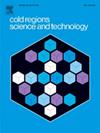粉质砂土冻胀力学及微ct研究
IF 3.8
2区 工程技术
Q1 ENGINEERING, CIVIL
引用次数: 0
摘要
在寒冷地区,土壤冻结是自然发生的,它影响着岩土工程实践和基础设施的许多方面。此外,人工冻结不仅可以在取样前稳定砂质和粉质土,还可以作为隧道和露天开挖的稳定措施。本文报道了来自Øysand挪威岩土工程试验场的四种粉质砂土的冻胀响应的实验室研究。为了评估冻融循环的影响,在一维单元中采用平行微型计算机断层扫描研究了细粒含量和垂直有效应力的联合影响。正如预期的那样,细粒含量越高,冻结时的膨胀越大,增加垂直有效应力可以减少或消除冻胀,抑制冻胀所需的应力水平随着细粒含量的增加而增加。此外,微ct图像分析增加了重要的进一步见解,并表明冻结可能会扰乱土壤结构,即使所得的整体应变太小,无法通过传统手段(使用LVDT)测量。这些实验提供了重要的证据,说明在何种情况下,地面冻结可以有效地辅助粉质砂的低干扰取样,并为此类地层的其他地质工程应用提供了有用的信息。本文章由计算机程序翻译,如有差异,请以英文原文为准。
Mechanical and micro-CT study of frost-heave in silty sands
Soil freezing occurs naturally in cold regions where it affects many aspects of geotechnical practice and infrastructure. Moreover, artificial ground freezing can be used to stabilize sandy and silty soils prior sampling, but also as stabilization measure in tunnelling and open excavations. This paper reports a laboratory-based study on the frost-heave response of four silty sand soils from the Øysand Norwegian geotechnical test site. The combined effects of fines content and vertical effective stresses were investigated in a one-dimensional cell with parallel micro-computed tomography to assess the impact of a freeze-thaw cycle. As expected, the higher the fines content the higher the expansion noted on freezing and increasing the vertical effective stress reduced or eliminated frost-heave, the stress levels required to supress heave increasing with fines content. Additionally, micro-CT image analysis added important further insights and shows that freezing may disturb the soil fabric, even when the resulting global strains are too small to measure by conventional means (using an LVDT). The experiments provided crucial evidence regarding the circumstances under which ground freezing could be an effective aid to low-disturbance sampling in silty sands and provides useful information for other geocryological engineering applications in such strata.
求助全文
通过发布文献求助,成功后即可免费获取论文全文。
去求助
来源期刊

Cold Regions Science and Technology
工程技术-地球科学综合
CiteScore
7.40
自引率
12.20%
发文量
209
审稿时长
4.9 months
期刊介绍:
Cold Regions Science and Technology is an international journal dealing with the science and technical problems of cold environments in both the polar regions and more temperate locations. It includes fundamental aspects of cryospheric sciences which have applications for cold regions problems as well as engineering topics which relate to the cryosphere.
Emphasis is given to applied science with broad coverage of the physical and mechanical aspects of ice (including glaciers and sea ice), snow and snow avalanches, ice-water systems, ice-bonded soils and permafrost.
Relevant aspects of Earth science, materials science, offshore and river ice engineering are also of primary interest. These include icing of ships and structures as well as trafficability in cold environments. Technological advances for cold regions in research, development, and engineering practice are relevant to the journal. Theoretical papers must include a detailed discussion of the potential application of the theory to address cold regions problems. The journal serves a wide range of specialists, providing a medium for interdisciplinary communication and a convenient source of reference.
 求助内容:
求助内容: 应助结果提醒方式:
应助结果提醒方式:


